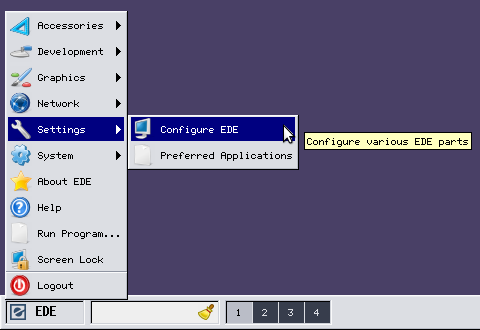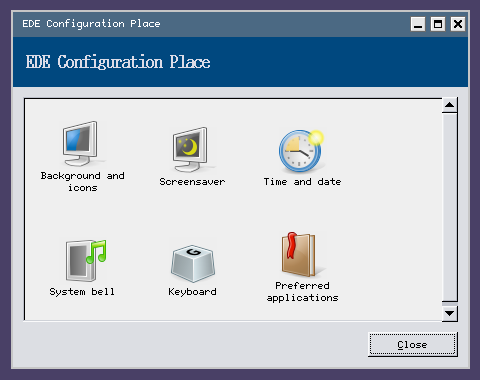This is an old revision of the document!
Table of Contents
EDE can be configured in many aspects.
You don't like the default behaviour of something? Don't panic! There's a good chance that you can change it. (And if you really can't, feel free to post a feature request on the bug tracker!)
Graphical configuration
The more obvious way to adjust EDE's behaviour is via the graphical configuration tools (see screenshots below).
The “Configuration place” can be accessed from the menu in the settings category.
It provides six tools to customize EDE to your liking. These should be pretty self-explanatory.
Background and icons
Here you can change the background colour or set a wallpaper, change icon properties and fonts.
Screensaver
This tool lets you configure a screensaver.
Time and date
Displays a calendar and a clock.
System bell
Provides volume control.
Keyboard
Lets you choose a keyboard layout for your country.
Preferred applications
Set your preferred terminal emulator, file manager, browser and mail client.
Advanced configuration
You can change a lot of settings for EDE which cannot (yet) be set using a graphical configuration utility. So for now you're stuck with editing configuration files in that case.
But that should be no problem, right? At least not when you know what EDE's configuration files are and where they can be found.
Just backup your configuration and start exploring what can be done! We'll cover some common examples later.
User dependent configuration
By default, EDE comes with a bundled version of pekwm. Configuration files for both are separate.
Configuring EDE
EDE places configuration files that affect the current user only in the directory ~/.config/ede.
As of version 2.1 you can find the following files there:
- ede-desktop-icons.conf
- ede-keyboard.conf
- ede-panel.conf
- ede-settings.conf
Configuring Pekwm
Pekwm's configuration files can be found in ~/.pekwm.
Currently there are the following files there:
- autoproperties
- config
- keys
- menu
- mouse
- start
- vars

